
Iowa is an easy-going midwestern state with 56,857 square miles of farmlands, grasslands, wetlands, and woodlands. Nearly 3,200,000 people live in Iowa, along with 433 species of birds!
Iowa state bird is the American Goldfinch – one of the most cheerful and beautiful little birds of the state. This bird’s bright yellow plumage and happy chippering calls are appreciated and enjoyed throughout the state.
On this page
Iowa State Bird
The American Goldfinch became the official state bird of Iowa on March 22, 1932. On that date, after house representative J. Wilbur Dole suggested that a vote be held, the Iowa House and Senate voted to accept this species as a symbol of the state.
During the late 1920s, many states were encouraged to pick an official state bird. Iowa was no exception, and in 1926, the Iowa Ornithologists’ Union had discussions about choosing the bird that best represented their state.
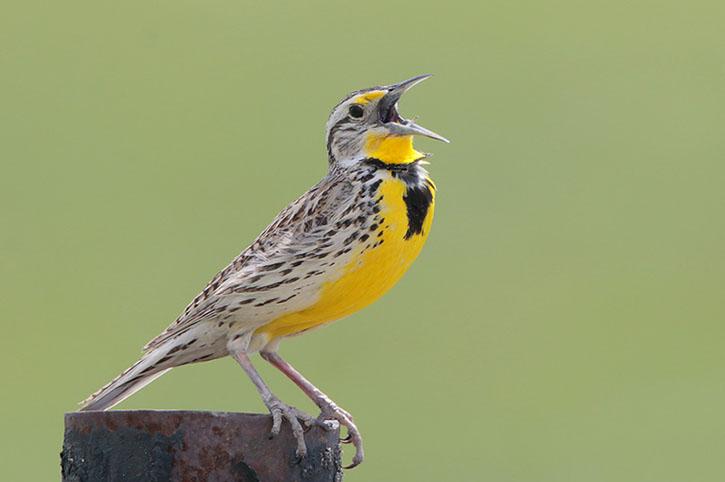
The Western Meadowlark was a strong contender for the title
The Western Meadowlark was a strong contender along with the Downy Woodpecker, Black-capped Chickadee, and American Goldfinch.
In 1927, the ornithologists decided that the best way to pick the state bird would be for children to vote for it.
Their plan was to send a list of the top five bird species to grade schools in every county and have children vote for their favorite bird. The vote was to take place on the Iowa’s official bird day, March 21st but for some reason, it never happened.
After a few years, the topic came up for discussion again and the Iowa Ornithologists’ Union held their own vote. They picked the American Goldfinch because this species is found in Iowa all year long, is common, and is a beautiful, brightly colored bird.
Fun Facts about American Goldfinches
- The state bird for Washington and New Jersey too. American Goldfinches are common birds in most parts of the USA. Their endearing appearance and song helped this species become the official bird for three different states.
- The “Wild Canary”. On account of its yellow plumage, complex song, and common distribution, another name for this species is the “Wild Canary.”
- They nest later than most other birds. While most birds nest in the spring, American Goldfinches don’t make a nest until June and July. These months are when a lot more seeds are available for this seed-eating bird.
- They change their feathers twice per year. Although most birds change their feathers once per year, the American Goldfinch molts two times a year; once in winter, and another time in late fall.
- Cowbirds can’t survive in American Goldfinch nests. Once in a while, a Brown-headed Cowbird will lay an egg in an American Goldfinch nest. The egg hatches but the nestling cowbird dies a few days later from starvation. It can’t survive on a diet that includes seeds and nothing else.
- A vegetarian. American Goldfinches are one of the few bird species that only eat seeds.
- Migrate just south of freezing weather. American Goldfinches migrate to areas just south of regions with temperatures stay below freezing for extended periods of time.
Identification
The American Goldfinch is a small finch around the same size as a sparrow. In all plumages, they have a black and white, forked tail, pale rump, and white undertail.
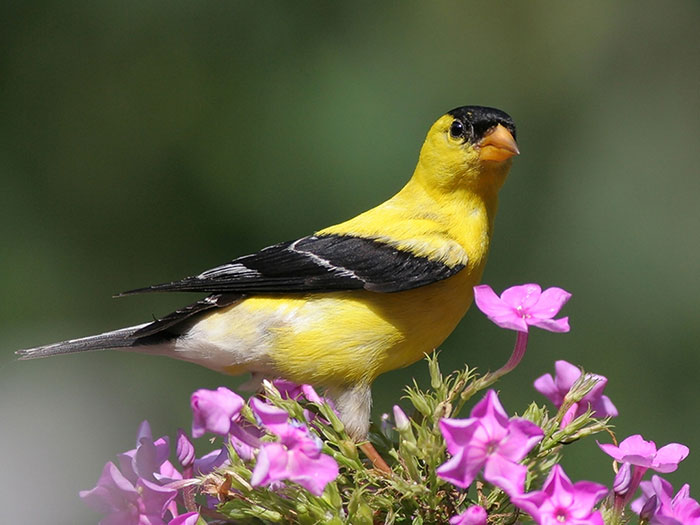
In their summer plumage, males are a beautiful bright yellow, have a black cap, a pale conical beak, and white markings on long black wings.
Females and wintering birds of both sexes have a couple of buffy or yellowish wings bars and buff, gray, and yellowish plumage.
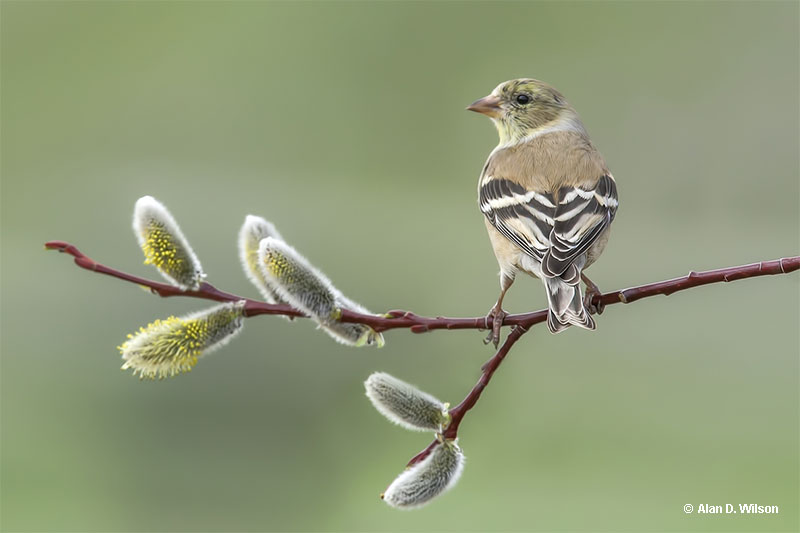
Female American Goldfinch © Alan D. Wilson
In flight, American Goldfinches seem to bound up and down through the air. They usually occur in small flocks, especially during the winter months, and are regular visitors to feeders.
Male American Goldfinches in breeding plumage are easily recognized by their bright yellow plumage with a black cap, and black and white wings and tail.
See more: 17 finch species you can see in the U.S.
Females and winter males are identified by their unstreaked plumage with yellow highlights, short forked tail, and dark wings with two yellow wing bars.
What do American Goldfinches eat?
American Goldfinches feed on seeds and little else. They forage for a wide variety of seeds by perching in thistle, grasses, and other “weedy” plants, and using their beaks to pick seeds from the vegetation.
They eat seed after seed while perched although goldfinches can also pick seeds from the ground and eat seeds in trees. A few of the tree species they feed on include American White Cedar, Alder, and Birch.
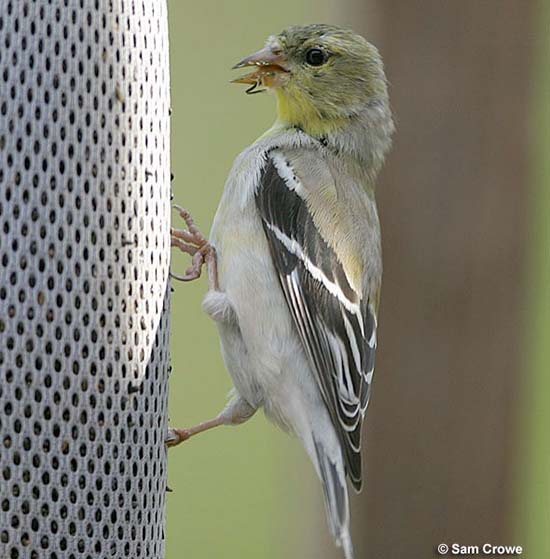
These little birds are also regular visitors to bird feeders. Although they can perch sideways or upside down, while feeding, they prefer to stand upright.
At feeders, some of their favorite seeds are Sunflowers seeds, and Thistle (or Nyger) seeds.
Behavior
The American Goldfinch spends most of its time in flocks of a dozen or a couple dozen birds that move around in search of seeding grasses and other plants.
They prefer weedy fields and second growth, and are common at feeders, especially in spring and fall.
This species makes use of grass, vegetation, and other soft materials to craft a small, woven cup nest. It builds its nest in the top part of a shrub or a low tree, and only nests when seeds are available in Thistle and other food plants.
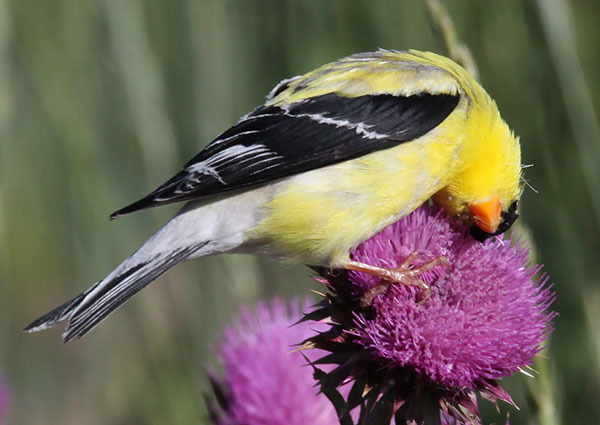
American Goldfinches are summer birds in southern Canada, California, and the northern half of the USA. In winter, we also find them in most of the USA and parts of Mexico. However, when temperatures drop below freezing, they fly south to warmer areas.
This small bird species doesn’t pose any sort of threat to people or pets. Instead, they have to be careful of a variety of predators that prey on them. Goldfinches move around in flocks for protection from Sharp-shinned Hawks and Cooper’s Hawks, shrikes, Merlins and other falcons, various owl species, and domestic cats.
Related: Hawks in Iowa
While they are nesting, American Goldfinches can also be attacked by jays, crows, grackles, snakes, squirrels, and other animals hoping to eat eggs and baby birds.
Frequently Asked Questions
How many bird species are in Iowa?
In total, 433 bird species have been found in Iowa.
What is the rarest bird in Iowa?
The rarest bird in Iowa is the Black Rail. This small, threatened species is very hard to see and may be an occasional very rare breeder. It mostly occurs in Iowa as an accidental migrant. Other rarer visitors to Iowa have included Eurasian waterfowl species such as the Tundra Bean Goose, Taige Bean Goose, and the Garganey.
What birds is Iowa known for?
Iowa is known for birds of open grassland habitats. The state is especially known for providing good breeding habitat for the Sedge Wren, Henslow’s Sparrow, and Bobolink.
Read next: Birds of Iowa | Hawks | Owls | Woodpeckers

